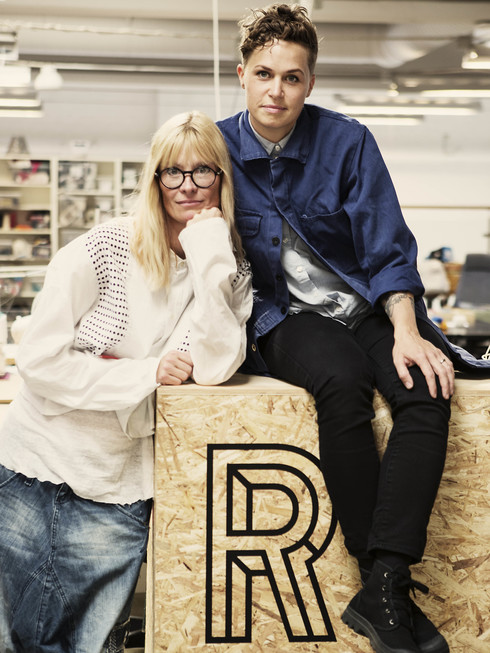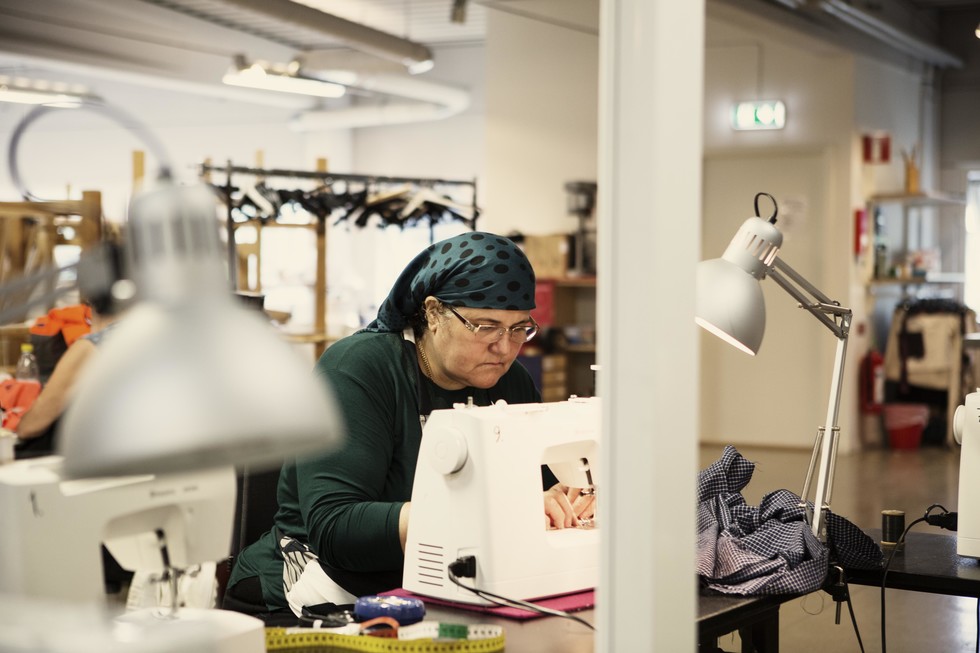An Interview with NHORM
Written by Felicia ErikssonMathilda Nilsson and Hanna Rudebeck are the brains behind the hot new Swedish fashion label Nhorm that is showing their collection for the first time during SS17 Stockholm Fashion Week this week.
Odalisque had the opportunity to visit their studio while the duo was preparing for FW.
Felicia: Tell us about Nhorm.
Mathilda: Nhorm started back in 2011 when we studied Fashion and Textile design together at the University of Borås in Sweden. When the year was coming to an end and Hanna was moving back to Malmö and I was going back to Stockholm, we both realized that we still wanted to have some kind of connection.
Hanna: We also helped each other with applications for different schools and we noticed that we worked very well together. So it was kind of a breakup and a new start combined.
M. Then we studied in different cities, Hanna in Copenhagen and myself at Konstfack in Stockholm, so we have worked apart until a year ago when we moved into this studio.
H. When we finished school we mentally decided to go 100% for this. We have focused a lot on the producing and selling aspects in the last six months, which is something new for us.
M. Before we handle the selling in a pretty idiotic way because we sold out our entire archive (laughs), that’s how we have funded all the new project.
F. How do you cooperate in the design process?
M. When you’re a duo, people get obsessed over who does what and who does that. My friends
were here last weekend and wondered what I had designed, and that’s not really the way things work.
H. However, the administrative work has increased and we have divided it between us.
M. In that way you can pretend that your company is larger than it really is and call yourself the financial manager and so on [laughs].
H. It's mostly Mathilda who makes the prints.
M. And you do more of the draping.
H. It happens inevitably when you work this tight with someone. You end up not knowing where the ideas came from, it’s constantly a mix.
F. The name Nhorm, what does it mean?
H. In fact, it's just our initials thrown around. It’s Nilsson, Hanna and the O is for ”och”, the Swedish word for “and”, just to connect it and then Rudebeck, Mathilda.
F. Do you have any constant source of inspiration?
M. The way we work with inspiration is constant. It’s a disrespectful mixture of different references.
H. The whole process is very visual. We pick elements from existing garments and we always work with several different methods. In our last collection we worked with the concept of panels so it was like a red thread and then we applied it to the garments. One thing that always have been a kind of theme is the idea of function and decoration.
M. It’s always these opposites. It’s very gratifying to say that right now we’re inspired by this but also this and they automatically become opposites. But then, you’re starting to find similarities between them and it’s quite fun because you don’t have to choose one side of them.
H. One thing that inspires us a lot in the beginning of the process is different materials and colors. Like the combination of two materials, or colors.
F. Do you feel that Nhorm is filling some kind of void in the existing fashion industry?
M. To get the opportunity to show at fashion week prove to us that we can do this. So I think that our work definitely have filled a blank space.
H. In Sweden absolutely however, internationally I think we’re a part of a bigger scene.
F. Your previous collection was shown at Amaze (an experimental arena for Swedish fashion, editors note) together with a few other selected designers. This time you will have your own show?
M. Yes, this time it's just us. To show at Amaze has of course been fantastic and we have learned so much, but now we are solo and that’s just super exciting.
H. It’s gonna be a completely different audience which we are ready for. This is the ultimate test, everything will be under the microscope. You can see right away if something is good or bad.
F. Last time at Amaze you decided to show the collection as a short movie. Will you play with the format of the presentation this time as well or will it be difficult with the classical format of a catwalk?
H. Yeah, we have dropped that thought now but we’ve had a lot of ideas about how to continue on the same path with the different angles and the controlled gaze. Instead we will use these thoughts in all the material created around the collection.
F. Berns may also be a very limited place to show?
H. Yes, but at the same time it feels great, Berns is like the center and the heart of fashion week.
M. We were honestly quite afraid in the beginning, but now it feels great.
H. I’m really looking forward to the day of the show. We take care of the seating and guest list and so on. We have a bunch of friends who will help us with that so I think it’s gonna be a really good atmosphere there. We can go into that room and make it ours. Its gonna be like a huge Nhorm party [laughs].
F. Tell us about the new collection!
H. It’s called TRIBUTE and its a continuation of the previous collection 'themewise'.
We’ve beeninspired by female RnB artists and the late 90s. There’s a lot of very strange and very glittery tops and baggy jeans. So we’ve been inspired by that whole silhouette and the materials.
M. You know that TLC video when they wearing those silk pyjamas? There’s a lot of contrasts in that world that speaks to us. The collection is a remix of a remix. There’s these yummy and colorful colors. Pink and bright yellow. And that Lil’ Kim picture hanging over there at our inspiration board. She has this very short skirt and a top on the red carpet. It’s a little weird and disrespectful.
H. I really do hate this word but, its very much a game, they have fun with it. TRIBUTE is not a anxious collection. It’s very direct and very visual.
M. And also very carefree, which is pretty much who we are.





























